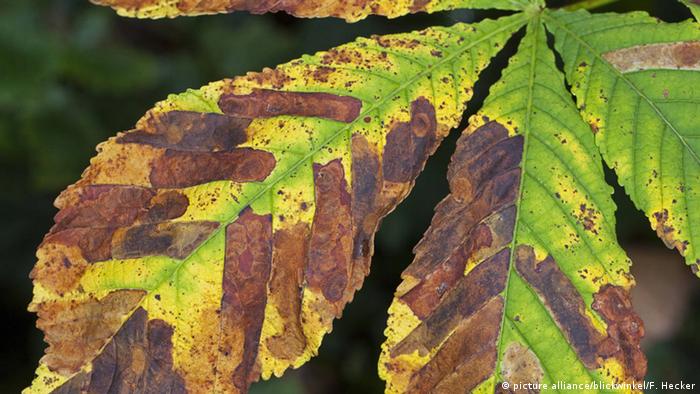Fifty-eight percent of the 265 tree species native only to Europe face a high to extreme risk of dying out, according to a study published Friday by the International Union for Conservation of Nature (IUCN).
The IUCN, which is known for its "Red List" classification of endangered species, said trees were under pressure from "invasive and problematic" species, urban development and "unsustainable logging."
"Trees are essential for life on Earth, and European trees in all their diversity are a source of food and shelter for countless animal species such as birds and squirrels, and play a key economic role," according to a statement from the head of the IUCN's Red List unit, Craig Hilton-Taylor.
The study said 42% of the 454 tree species in Europe, which include some found elsewhere, could die out on the continent.
Sixty-six species were considered "critically endangered," a classification denoting that they are one step away from extinction.
Read more: Threatened tortoises: Stopping the fast extinction of a slow-moving creature
Invasive moth
Among the species on the endangered list is the horse chestnut, or conker tree, which is being attacked by the leaf-miner moth, an insect species that has spread from the Balkan mountains to the rest of Europe.
The mountain ash and the Crimean rowan have also made their way onto the list, which was the result of work by more than 150 experts.
The IUCN, based in Gland, Switzerland, has observer and consultative status at the United Nations. Its latest assessment of biodiversity comes on the heels of warnings from the UN in May that 1 million plant and animal species are on the brink of extinction, with climate change and habitat loss major contributors to their plight.
-
8 species on the brink in 2019
Northern white rhino
This white rhino subspecies made headlines last year following the death of Sudan, the last known male of his kind, making the species functionally extinct. Some scientists are cautiously optimistic that it could be brought back with the help of IVF technology, while others say time has simply run out for the subspecies, meaning it won't be long before it disappears.
-
8 species on the brink in 2019
South China tiger
The South China tiger is the most critically endangered of all tiger subspecies. No individual has been sighted in the wild since 1970, while the global captive population is likely to number less than 80. Some researchers have already declared the subspecies functionally extinct, but organizations such as Save China's Tigers (SCT) are persisting with their conservation efforts.
-
8 species on the brink in 2019
Amur leopard
Fewer than 80 Amur leopards are believed to live in the wild, making it one of the rarest cats on the planet. Native to the forests of Southern China, Northern Russia and the Korean Peninsula, the amur leopard is threatened by poaching and deforestation. But there's still some hope — the leopard has found an unlikely refuge in the Korean Demilitarized Zone, which has become a haven for wildlife.
-
8 species on the brink in 2019
Vaquita
Also known as the gulf porpoise, the vaquita is the rarest marine animal in the world, with less than 15 thought to exist as of March 2018. The porpoise has never been hunted directly but it often becomes entangled in illegal gillnets intended to capture the totoaba, another critically endangered fish found in the Gulf of California. Efforts to stop illegal fishing in the area have largely failed.
-
8 species on the brink in 2019
Black rhino
Researchers fear the black rhino could suffer the same fate as its northern white cousin if conservation efforts aren't ramped up soon. The population currently numbers just over 5,000 individuals, although three subspecies have already been declared extinct. They are primarily threatened by illegal poaching, driven largely by demand for rhino horn on the black market.
-
8 species on the brink in 2019
Red wolf
With fewer than 30 remaining in the wild, the red wolf is considered critically endangered and is the focus of conservation efforts. It's actually a genetic mix between the gray wolf and the coyote, and was decimated in the 1960s thanks to intensive predator control programs. The shy subspecies is native to the southeastern US and Florida, but today is only found in eastern North Carolina.
-
8 species on the brink in 2019
Saola
First discovered in 1992, the elusive saola is often dubbed the 'Asian unicorn.' In fact, it's so rare that there have only been four confirmed sightings in the wild by researchers. They are found in the forests of Vietnam and Laos and are threatened by poaching and habitat destruction. The population is believed to have rapidly declined since its discovery, with no more than 100 likely to exist.
-
8 species on the brink in 2019
Eastern gorilla
The largest living primate is critically endangered thanks to illegal hunting and deforestation. The lowland gorilla subspecies is more populous with 3,800 thought to live in the wild, while only about 880 mountain gorillas are thought to exist. Although conservation efforts have been lauded in recent years, there is still a long way to go before the population will be considered stable.
Author: Ineke Mules
tj/ng (dpa, AFP, AP)
Each evening at 1830 UTC, DW's editors send out a selection of the day's hard news and quality feature journalism. You can sign up to receive it directly here.
from Hacker News https://ift.tt/2mh2BuF

No comments:
Post a Comment
Note: Only a member of this blog may post a comment.